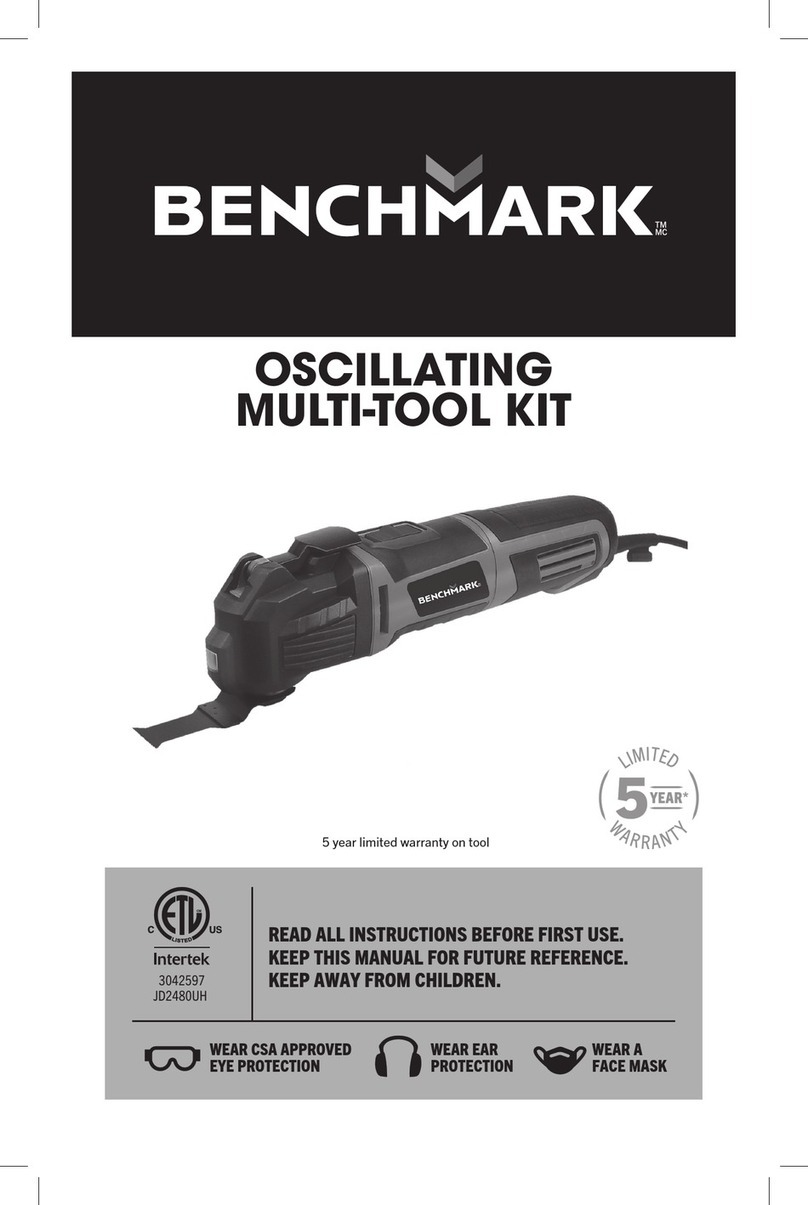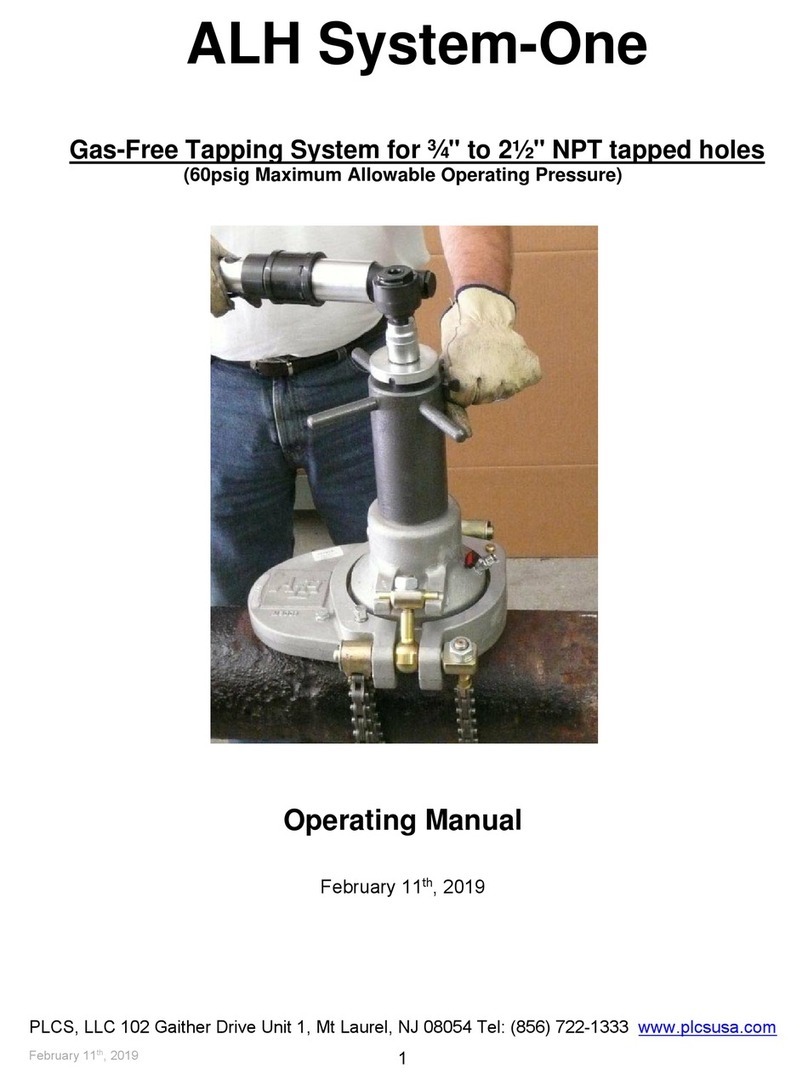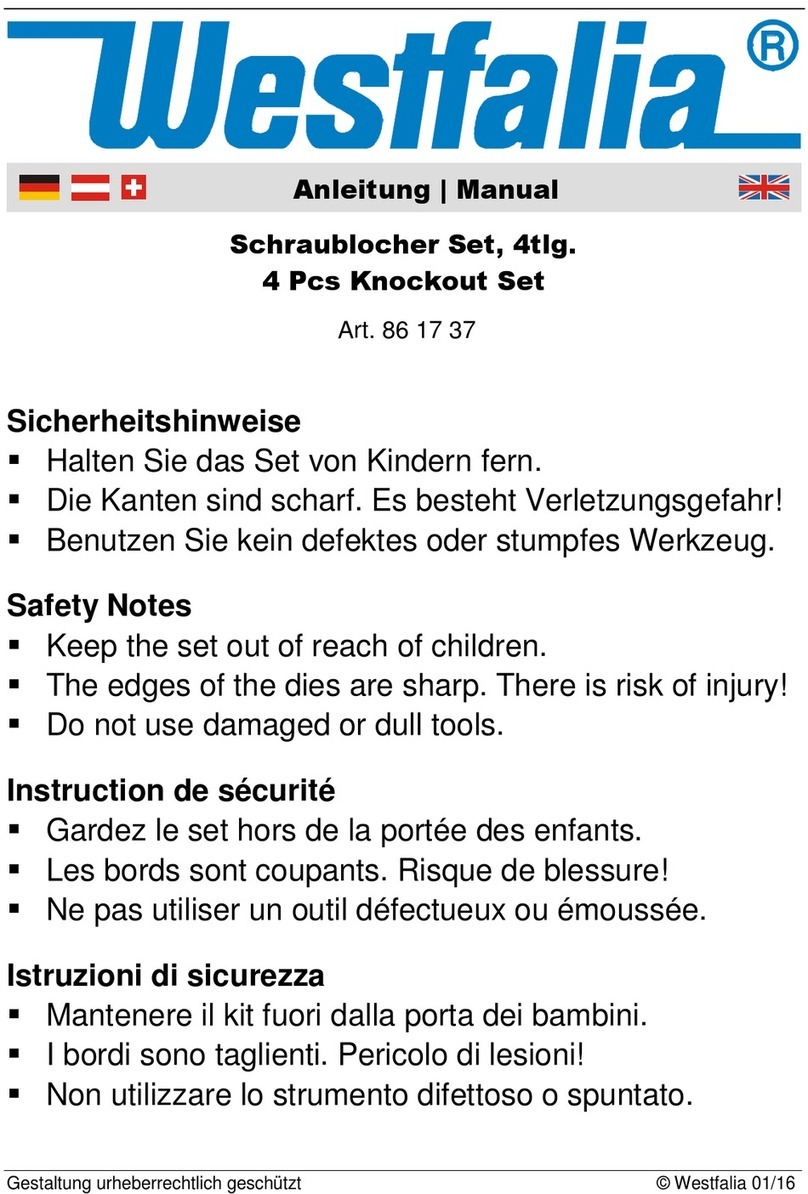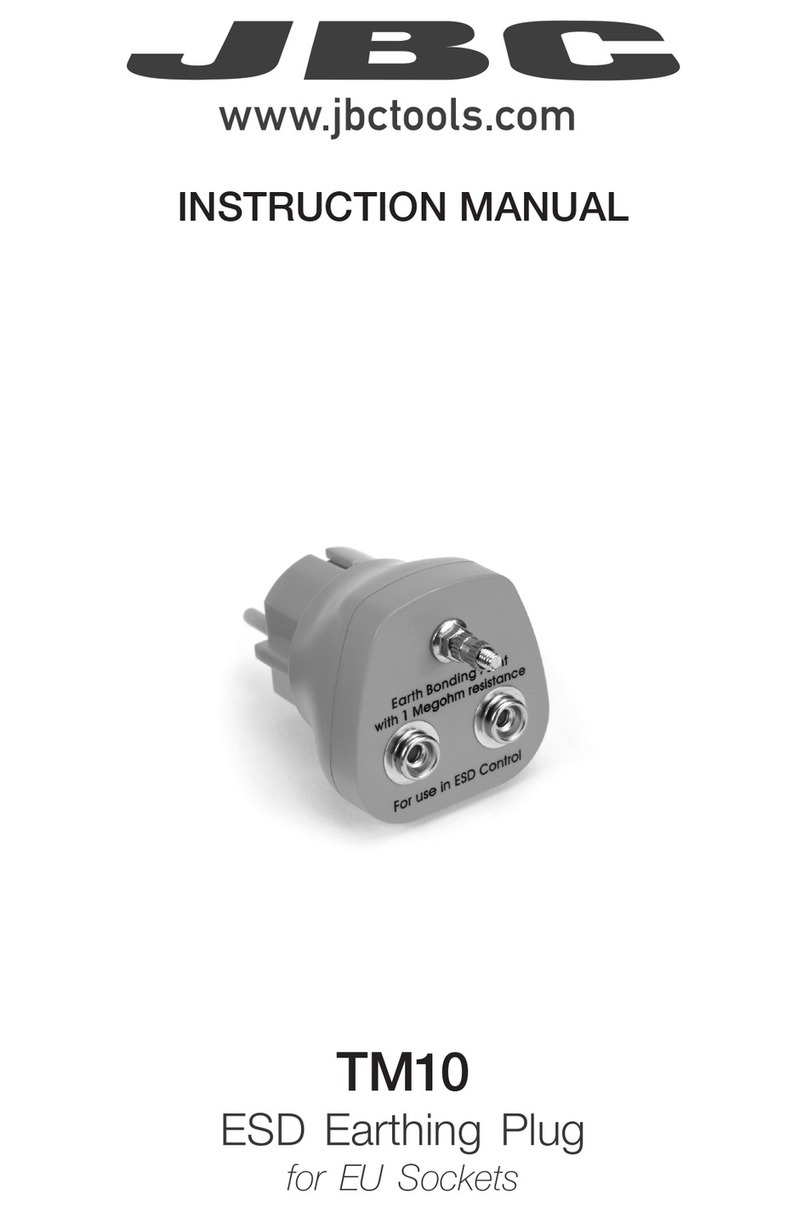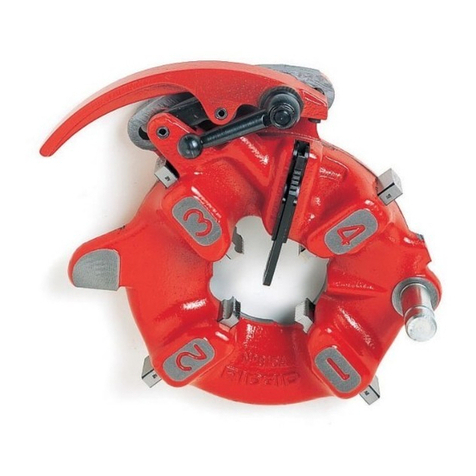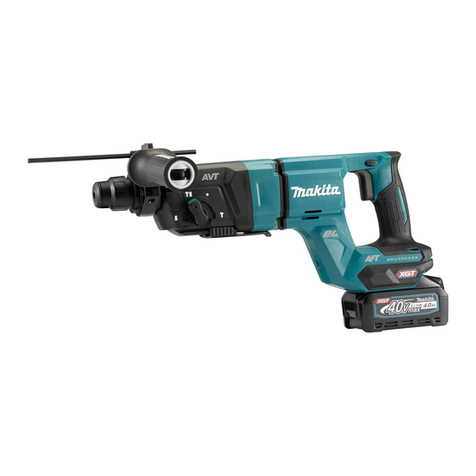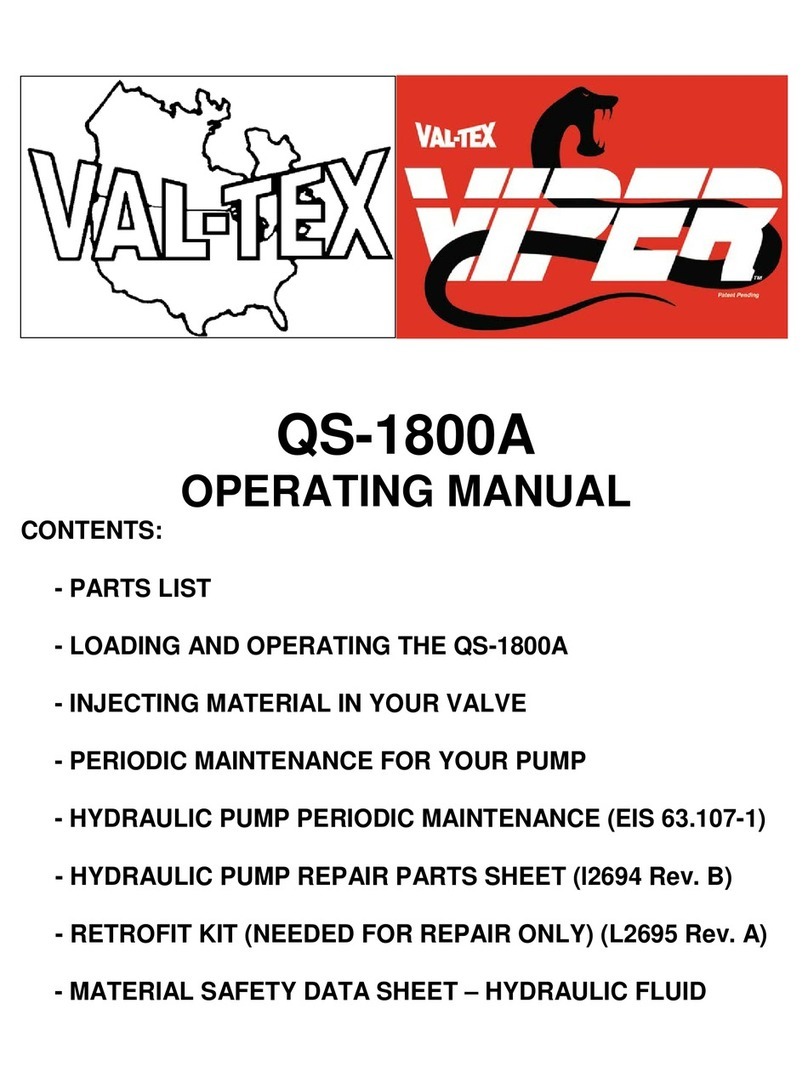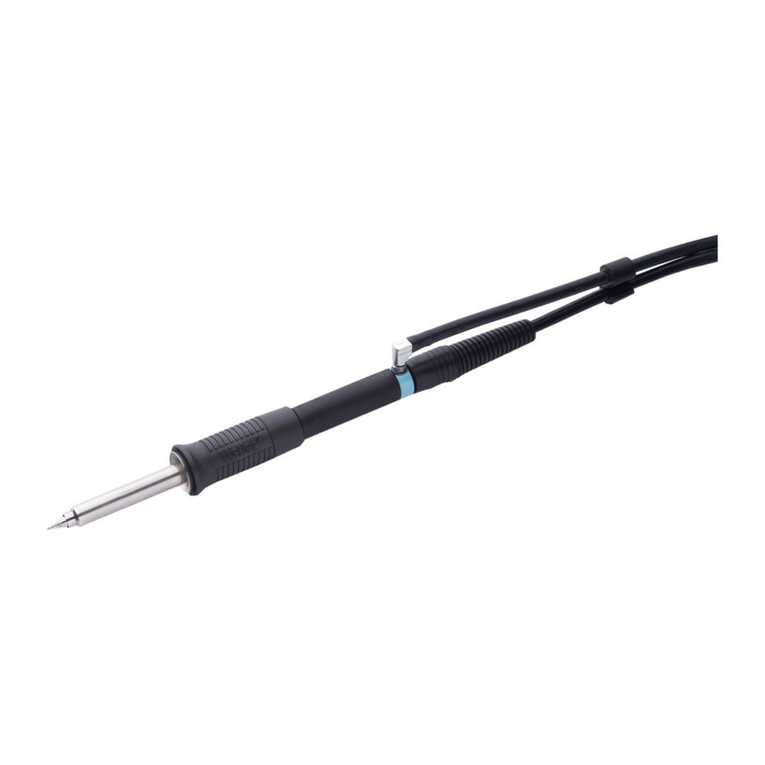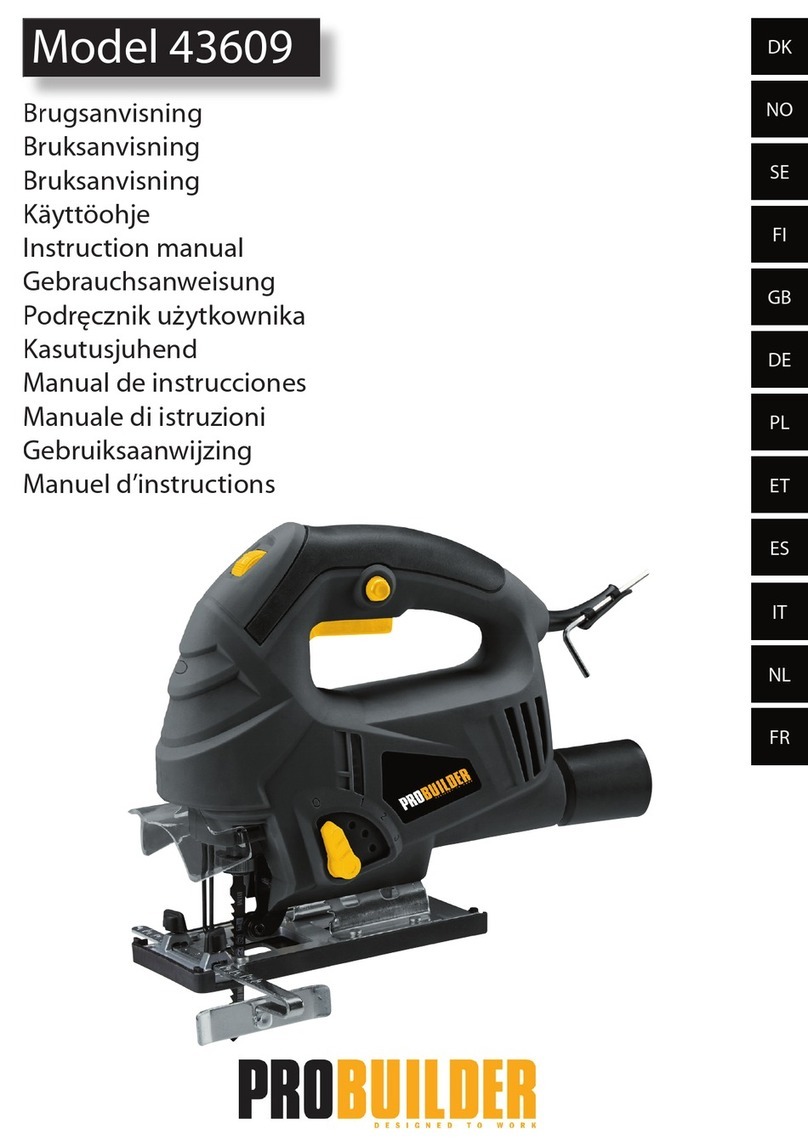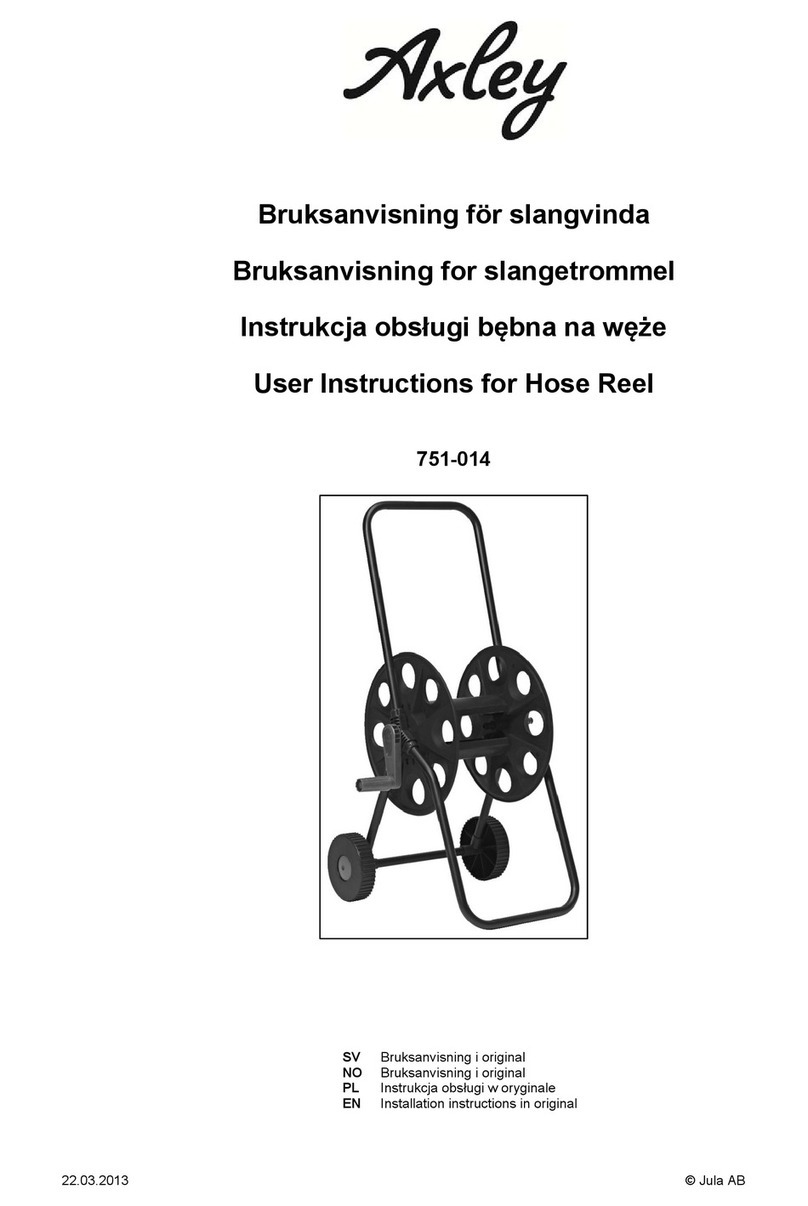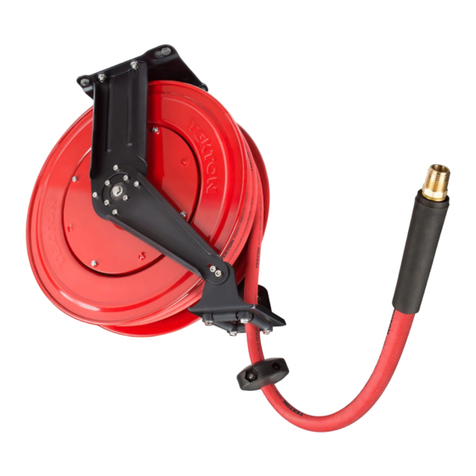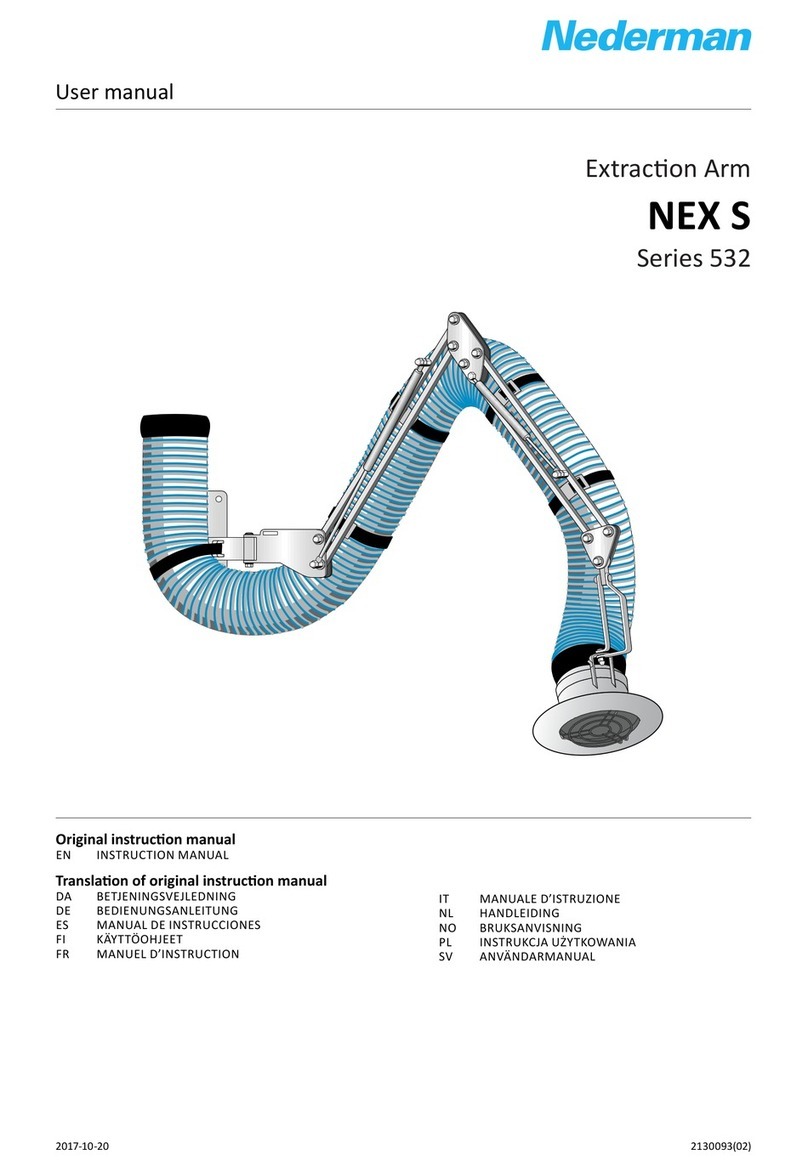Benchmark 1280-000 User manual

ELECTRONIC
ROTARY TOOL KIT
WEAR CSA APPROVED
EYE PROTECTION
WEAR EAR
PROTECTION
WEAR A
FACE MASK
5 year limited warranty on tool

1
PRODUCT SPECIFICATIONS
BENCHMARK 1.6 AMP ROTARY TOOL
Rating 120V, 60Hz, AC
Amperes 1.6 Amp
RPM 5,000–35,000 RPM (no load)
Chuck type 3-jaw
Chuck capacity 1/16" to 1/8"
Weight 5.1lb (2.3 kg)
NEED ASSISTANCE?
Call us on our toll- free customer support line:
1-866-349-8665 (Monday through Friday 9am – 5pm Eastern Standard Time)
• Technical questions
• Replacement parts
• Parts missing from package

1280-000
ELECTRONIC ROTARY TOOL KIT
2
TABLE OF CONTENTS
Product Specifications .................................................................................. 1
Table of Contents .......................................................................................... 2
General Safety Warnings ............................................................................ 3-5
Specific Safety Rules ..................................................................................... 6
Extension Cord Safety ................................................................................... 7
Symbols ........................................................................................................ 8
Know Your Rotary Tool.................................................................................... 9
Accessories ............................................................................................ 10-12
Assembly and Operating ......................................................................... 13-18
Installing Accessory Bits ............................................................................. 13
Removing the 3-jaw Chuck and Installing a Collet ................................... 13-14
Installing Accessory Bit when Using the Collet Nut System ........................... 14
Connecting the Flexible Shaft to the Tool ................................................ 14-15
Changing the Collet and Accessories in the Flexible Shaft ............................ 15
Installing the LED Worklight ......................................................................... 16
Replacing batteries in LED Worklight ...................................................... 16-17
ON/OFF Switch ........................................................................................... 17
Speed Control Wheel ................................................................................... 18
Selecting the Proper Speed ......................................................................... 18
Maintenance .......................................................................................... 19-20
Exploded View ............................................................................................ 21
Parts List ............................................................................................... 22-23
Warranty ..................................................................................................... 24

3
GENERAL SAFETY WARNINGS
WARNING:
Before using this tool or any of its accessories, read this manual and follow all Safety
Rules and Operating Instructions. The important precautions, safeguards and
instructions appearing in this manual are not meant to cover all possible situations.
It must be understood that common sense and caution are factors which cannot be
built into the product.
EYE, EAR & LUNG PROTECTION
SYMBOL MEANING
ALWAYS WEAR EYE PROTECTION THAT CONFORMS
WITH CSA Z94.3 or ANSI SAFETY STANDARD Z87.1
FLYING DEBRIS can cause permanent eye damage.
Prescription eyeglasses ARE NOT a replacement for proper eye protection.
Non-compliant eyewear can cause serious injury if broken
during the operation of a power tool.
Use hearing protection, particularly during extended periods
of operation of the tool, or if the operation is noisy.
WEAR A DUST MASK THAT IS DESIGNED TO BE
USED WHEN OPERATING A POWER TOOL IN A
DUSTY ENVIRONMENT.
Dust that is created by power sanding, sawing, grinding, drilling, and other
construction activities may contain chemicals that are known to cause cancer,
birth defects, or other genetic abnormalities. These chemicals include:
• Lead from lead-based paints
• Crystalline silica from bricks, cement, and other masonry products
• Arsenic and chromium from chemically treated lumber.
The level of risk from exposure to these chemicals varies, according to how
often this type of work is performed. In order to reduce exposure to these
chemicals, work in a well-ventilated area, and use approved safety equipment,
such as a dust mask that is specifically designed to filter out microscopic
particles.
ELECTRICAL SAFETY
WARNING:
To avoid electrical hazards, fire hazards or damage to the tool, use proper circuit
protection.
This tool is wired at the factory for 120V AC operation. It must be connected to a
120V AC, 15 A circuit that is protected by a time-delayed fuse or circuit breaker.
To avoid shock or fire, replace power cord immediately if it is worn, cut or damaged
in any way.

1280-000
ELECTRONIC ROTARY TOOL KIT
4
POWER TOOL SAFETY
WARNING:
Read all safety warnings and instructions. Failure to follow the warnings and
instructions may result in electric shock, fire and/or serious injury.
SAVE ALL WARNINGS AND INSTRUCTIONS FOR FUTURE REFERENCE.
WORK AREA SAFETY
Keep work area clean and well lit. Cluttered or dark areas invite accidents.
Do not operate power tools in explosive atmospheres, such as in the presence of
flammable liquids, gases or dust. Power tools create sparks which may ignite the
dust or fumes.
Keep children and bystanders away while operating a power tool. Distractions can
cause you to lose control.
ELECTRICAL SAFETY
Power tool plugs must match the outlet. Never modify the plug in any way. Do not
use any adapter plugs with earthed (grounded) power tools. Unmodified plugs and
matching outlets will reduce risk of electric shock.
Avoid body contact with earthed or grounded surfaces such as pipes, radiators,
ranges and refrigerators. There is an increased risk of electric shock if your body is
earthed or grounded.
Do not expose power tools to rain or wet conditions. Water entering a power tool will
increase the risk of electric shock.
Do not abuse the cord. Never use the cord for carrying, pulling or unplugging the
power tool. Keep cord away from heat, oil, sharp edges or moving parts. Damaged or
entangled cords increase the risk of electric shock.
When operating a power tool outdoors, use an extension cord suitable for outdoor
use. Use of a cord suitable for outdoor use reduces the risk of electric shock.
If operating a power tool in a damp location is unavoidable, use a residual current
device (RCD) protected supply. Use of a ground fault circuit interrupter (GFCI)
reduces the risk of electric shock.
PERSONAL SAFETY
Stay alert, watch what you are doing and use common sense when operating a
power tool. Do not use a power tool while you are tired or under the influence of
drugs, alcohol or medication. A moment of inattention while operating power tools
may result in serious personal injury.
Use personal protective equipment. Always wear eye protection. Protective
equipment such as dust mask, non-skid safety shoes, hard hat, or hearing
protection used for appropriate conditions will reduce personal injuries.
Prevent unintentional starting. Ensure the switch is in the OFF position before
connecting to power source and/or battery pack, picking up or carrying the tool.
Carrying power tools with your finger on the switch or energizing power tools that
have the switch on invites accidents.

5
Remove any adjusting key or wrench before turning the power tool on. A wrench or a
key left attached to a rotating part of the power tool may result in personal injury.
Do not overreach. Keep proper footing and balance at all times. This enables better
control of the power tool in unexpected situations.
Dress properly. Do not wear loose clothing or jewellery. Keep your hair, clothing and
gloves away from moving parts. Loose clothes, jewellery or long hair can be caught
in moving parts.
If devices are provided for the connection of dust extraction and collection facilities,
ensure these are connected and properly used. Use of dust collection can reduce
dust-related hazards.
POWER TOOL USE AND CARE
Do not force the power tool. Use the correct power tool for your application. The
correct power tool will do the job better and safer at the rate for which it was
designed.
that cannot be controlled with the switch is dangerous and must be repaired.
Disconnect the plug from the power source and/or the battery pack from the
power tool before making any adjustments, changing accessories, or storing power
tools. Such preventive safety measures reduce the risk of starting the power tool
accidentally.
Store idle power tools out of the reach of children and do not allow persons
unfamiliar with the power tool or these instructions to operate the power tool. Power
tools are dangerous in the hands of untrained users.
Maintain power tools. Check for misalignment or binding of moving parts, breakage
damaged, have the power tool repaired before use. Many accidents are caused by
poorly maintained power tools.
Keep cutting tools sharp and clean. Properly maintained cutting tools with sharp
cutting edges are less likely to bind and are easier to control.
Use the power tool, accessories and tool bits etc. in accordance with these
instructions, taking into account the working conditions and the work to be
result in a hazardous situation.
Keep handles and grasping surfaces dry, clean and free from oil and grease.
Slippery handles and grasping surfaces do not allow for safe handling and control of
the tool in unexpected situations.
SERVICE
Have your power tool serviced by a qualified repair person using only identical
replacement parts. This will ensure that the safety of the power tool is maintained.
SAVE THESE INSTRUCTIONS FOR REFERENCE

1280-000
ELECTRONIC ROTARY TOOL KIT
6
SPECIFIC SAFETY RULES
WARNING:
Know your rotary tool. Do not plug the tool into the power source until you have
read and understand this Instruction Manual. Learn the tool’s applications and
limitations, as well as the specific potential hazards related to this tool. Following
this rule will reduce the risk of electric shock, fire, or serious injury.
Always wear eye protection. Any power tool can throw foreign objects
into your eyes and cause permanent eye damage.
ALWAYS wear safety goggles (not glasses) that comply with ANSI safety standard
Z87.1. Everyday glasses have only impact resistant lenses. They ARE NOT safety
glasses.
WARNING: Glasses or goggles not in compliance with ANSI Z87.1 could
cause serious injury when they break.
Hold tool by insulated gripping surfaces when performing an operation where the
cutting tool may contact hidden wiring or its own cord. Contact with a “live” wire will
make exposed metal parts of the tool “live” and shock the operator.
Always make sure the work surface is free from nails and other foreign objects.
Cutting into a nail can cause the bit and the tool to jump and damage the bit.
Never hold the workpiece in one hand and the tool in the other hand when in use.
Never place the hands near or below the cutting surface. Clamping the material and
guiding the tool with both hands is much safer.
Never lay workpiece on hard surfaces like concrete, stone, etc. Protruding cutting
bit may cause the tool to jump.
Always wear safety goggles and dust mask. Use only in well-ventilated area. Using
personal safety devices and working in a safe environment reduces risk of injury.
After changing the bits and accessories or making adjustments, make sure
the collet nut and any other adjustment devices are securely tightened. Loose
adjustment devices will be violently thrown.
Always use the correct collet size. If the collet size is larger than the accessory
shank size it will not grip the shank properly, leading to possible injury to the
operator or damage to the tool.
each use. Damaged accessories can break during use and cause serious injury.
Never use dull or damaged bits. Sharp bits must be handled with care. Damaged
bits can snap during use. Dull bits require more force to push the tool, possibly
causing the bit to break.
Never touch the bit during or immediately after use. After use the bit is too hot to be
touched by bare hands.

7
EXTENSION CORD SAFETY
WARNING:
Keep the extension cord clear of the working area. Position the cord so it will not get
caught on the workpiece, tools or any other obstructions while you are working with
the power tool.
Make sure any extension cord used with this tool is in good condition. When using
an extension cord, be sure to use one of heavy enough gauge to carry the current
the tool will draw. An undersized cord will cause a drop in line voltage resulting in
loss of power and overheating.
The table at below shows the correct size to use according to cord length and
nameplate ampere rating. If in doubt, use the next heavier gauge. The smaller the
gauge number the heavier the cord.
Be sure your extension cord is properly wired and in good condition. Always replace
a damaged extension cord or have it repaired by a qualified electrician before using
it. Protect your extension cord from sharp objects, excessive heat and damp or wet
areas.
Use a separate electrical circuit for your power tools. This circuit must not be less
than 14 gauge wire and should be protected with either a 15 AMP time delayed fuse
or circuit breaker. Before connecting the power tool to the power source, make sure
the switch is in the OFF position and the power source is the same as indicated on
the nameplate. Running at lower voltage will damage the motor.
MINIMUM GAUGE (AWG)
EXTENSION CORDS (120V USE ONLY)
Amperage Rating Total Length
More than Not more
than
25'
(7.5 m)
50'
(15 m)
100'
(7.5 m)
150'
(7.5) m
0 6 18 16 16 14
6 10 18 16 14 12
10 12 16 16 14 12
12 16 14 12 Not Applicable

1280-000
ELECTRONIC ROTARY TOOL KIT
8
SYMBOLS
WARNING: Some of the following symbols may appear on the ROTARY TOOL . Study
these symbols and learn their meaning. Proper interpretation of these symbols will allow
V Volts n
~
Three-phase alternating
current with neutral
A Amperes Read all safety warnings and
instructions
Hz Hertz Direct current
W Watts noNo load speed
kW Kilowatts Alternating or direct current
Microfarads Class II construction
L Liters Splash-proof construction
kg Kilograms Watertight construction
H Hours Protective grounding at
terminal, Class I tools
N/cm² Newtons per square
centimetre .../min Revolutions or reciprocations
per minute
Pa Pascals Diameter
OPM Oscillation per minute 0
Min Minutes Directional arrow
S Seconds Warning symbol
~or AC Alternating current Wear safety glasses, hearing
protection and dust mask
~
Three-phase alternating
current
This symbol designates that this tool is listed with U.S.
requirements by TÜV Rheinland. Conforms to UL60745-1,
UL60745-2-23.
Certified to CAN/CSA-C22.2 No.60745-1, CAN/CSA-C22.2
No.60745-2-23.

9
KNOW YOUR ROTARY TOOL
Umbrella nut
110 pc
Accessory kit
Collet nut
3-Jaw chuck
LED work light
Air vents
Hanging loop
Speed control
Motor brush
cap
ON/OFF
switch
Spindle lock
button
Flexible shaft
Table clamp
& hanger
1/8", 3/32",
1/16" Collets
Collet wrench

1280-000
ELECTRONIC ROTARY TOOL KIT
10
ACCESSORIES
Key # Part # Part Name Qty
Brass brush 1/4" Axial 1
Bristle brush 7/8" Radial 1
Brass brush 7/8” Radial 1
Bristle brush 1/4” Axial 1
Felt polishing wheel 1/2” 3
Felt polishing wheel 1" 3
Felt polishing tip tip 3/8” 3
Mandrel for felt
wheel 1/8” 1
Sanding band 1/2” 18
Drum sander with
1/8” shank 1/2” Diameter 1
Diamond ball 5/64" Taper 1
Diamond bit cylinder Cylinder 3
Diamond taper 5/64” Taper 1
Collets
Collets
Collets
Screw mandrel
Screw mandrel
1/8"
3/32"
1/16"
1/8"
1/8"
1
1
1
1
1
wheel
15/16" x 0.031
Thick
23
Dressing stone
Collet wrench
3/8" x 3/8" x 1" 1
1
Sanding disc 3/4" Circular 31
Various grinding
stones Assorted 10
Collet nut 1

11
ACCESSORIES
The following charts identify the most popular accessories and their uses.
NOTE: Please see the accessory case contents on Page 10 to identify the
accessories that are included with this rotary tool.
Accessory Description Accessory Use
Ideal for cutting, grooving and trimming all kinds of materials—in-
cluding metal, wood and ceramics. You can use it to cut screws and
rusted bolts, make slots in screw heads, trim castings and more.
Felt polishing wheel Ideal for polishing most metal surfaces and plastics. Can be used
with polishing compound.
Mandrel for felt Use with felt polishing wheels.
Sanding band for use
with drum sander
For rough shaping and smoothing wood and fiberglass; removing rust
from metal surfaces; shaping rubber surfaces. Sanding bands are
easily replaceable on drums.
Drum sander For use with sanding bands
Screw mandrel
Aluminum oxide grinding stones
& wheels (pink)
Use on metals, castings, welded joints, rivets and rust. Ideal for
sharpening, de-burring, rust removal and general-purpose grinding of
most materials.
Silicon carbide grinding stones
& wheels (green)
Designed to work well on stone, glass, ceramics, porcelain and
non-ferrous metals.
Bristle brush Use for light de-burring, cleaning and polishing of silverware, jewelry
and other precious metals. Can be used with polishing compound.
Brass brush Brass brushes are non-sparking and softer than steel. They will not
scratch soft metals like gold, copper, brass, etc.
Diamond point
Great for cutting, sawing and carving of hard materials such as
marble, concrete, brick, porcelain, ceramics, hard epoxy and soft
and hard wood.
Dressing stone Cleans grinding wheels and stones. Shapes or reshapes stones for
desired applications.
Collet For use with accessories.
Collet wrench For tightening & loosening collet nut, screw of drum sanders.
Multi-purpose drill bit Cuts wood, plastic, fiberglass, drywall, laminate and aluminum and
vinyl siding.
Stainless steel brush Stainless steel brushes do not cause "after-rust" when used on corro-
sive-resistant materials like pewter, aluminum and stainless steel.
Cloth wheel Use for polishing metal & plastics. Can be used with polishing
compound.
Rubber polishing wheel Use for removing small scratches and for polishing ferrous metals.

1280-000
ELECTRONIC ROTARY TOOL KIT
12
Accessory Description Accessory Use
Drill bit Use for drilling in wood, plastic and soft metals.
Cutting bit Use for cutting wood, plastic, fiberglass, aluminum, drywall and vinyl
siding.
Grinding disc Use for grinding metals, welds, rivets, rust etc.
Grinding compound Use with grinding stones and discs to increase the rate of material
removal.
Cutting guide
Use with cutting bit for precise cutting control. To install the cutting
guide on the rotary tool, remove the umbrella nut from the tool and
thread the cutting guide onto the exposed threads. To adjust the
cutting depth, loosen the thumb screw on the cutting guide and slide
the guide to the correct depth. Retighten the thumb screw.
NOTE: This rotary tool will accept all 1/8", 3/32" and 1/16" shanked accessories
not be compatible.

13
ASSEMBLY AND OPERATING
INSTALLING ACCESSORY BITS
1. Turn the switch OFF and disconnect
the tool from the power source.
2. Depress the spindle lock button
(1) and slowly turn the 3-jaw chuck
collet nut (2) until the spindle lock
button locks the spindle (Fig. 1).
3. While holding the spindle lock button
down, turn the 3-jaw chuck collet
nut counter clockwise until the 3-jaw
chuck jaws open far enough to allow
the accessory bit shank (3) to be
inserted into the 3-jaw chuck.
Fig. 1
4. Insert accessory shank into the 3-jaw chuck.
NOTE: Insert accessory shank at least 3/4" into the 3-jaw chuck.
5. Press the spindle lock button and engage it in the spindle. While holding the
spindle lock button down, hand-tighten the 3-jaw chuck by turning it clockwise.
NOTE: Do not use pliers to tighten the collet nut. Use the small wrench (4) supplied.
Over tightening will cause damage to the tool.
6. Pull on the accessory to ensure it is securely in place.
REMOVING THE 3-JAW CHUCK AND INSTALLING A COLLET
Insert accessory shank at least 3/4" into the 3-jaw chuck. In some instances you
may wish to remove the 3-jaw chuck and use the collet nut system to hold the
accessory bit. Collet sizes can be 1/8", 3/32" and 1/16". It is important to ensure
that the collet size matches the accessory.
NOTE: This tool includes the most commonly used collets: 1/8", 3/32" and 1/16".
WARNING: Using a collet that is too large for the accessory will result in the
accessory possibly being thrown from the tool causing serious injury.
1. Turn the tool switch OFF and remove the plug from the power source.
2. Depress the spindle lock button (1) and slowly turn the 3-jaw chuck (2) until the
spindle lock button locks the spindle (3) (Fig. 2).
3. While holding the spindle lock button down, turn the 3-jaw chuck counter
clockwise until both the 3-jaw chuck collet nut and the jaw assembly are
removed from the spindle.
4. Insert the appropriate sized collet (4) into the spindle and thread the collet nut
(5) onto the spindle by turning it clockwise while holding the spindle lock button
down.

1280-000
ELECTRONIC ROTARY TOOL KIT
14
NOTES:
a) The collet nut is supplied with
the tool.
b) Do not tighten the collet nut
without an accessory bit
installed in the collet. You will
damage the collet.
Fig. 2
INSTALLING ACCESSORY BIT WHEN USING THE COLLET NUT SYSTEM
1. Turn the switch to the OFF
position, and disconnect the plug
from the power source.
2. Depress the spindle lock button
(1), and slowly turn the collet nut
(2) until the spindle lock button
locks the spindle in place (Fig. 3).
3. Hold the spindle lock button down,
and turn the collet nut counter
clockwise until the collet is loose
inside the collet nut.
Fig. 3
4. Insert the shank of the accessory (3) into collet at least 3/4”.
NOTE: Verify that the proper collet is used for the accessory. If the collet is too
large, replace it with the next smaller size.
5. Press the spindle lock button, and engage it in the spindle. While holding the
spindle lock button down, turn the collet nut clockwise by hand to tighten it.
NOTE: Do not use pliers to tighten the collet nut. Use the collet wrench (4) that is
provided with the tool. Over-tightening the collet will damage the tool.
6. Pull on the accessory to verify that it is held securely in position.
CONNECTING THE FLEXIBLE SHAFT TO THE TOOL
WARNING: Do not bend the flexible shaft to a radius of less than 6” (15.2 cm)
when using it with the rotary tool. Store the flexible shaft carefully when it is not in
use, avoiding sharp bends.
1. Lock the spindle using the spindle lock button (1) open the 3-jaw chuck (2) as
shown in Fig. 4.
2. Insert the drive shaft (3) into the 3-jaw chuck as far as it will go.
3. Tighten the 3-jaw chuck onto the drive shaft as shown in Fig. 1.
NOTES:
a) Do not overtighten the 3-jaw chuck.

15
b) The flex shaft can also be attached to the tool using a 1/8" collet and collet nut.
Install the collet and collet nut as shown in Fig. 2.
CHANGING THE COLLET AND ACCESSORIES IN THE FLEXIBLE SHAFT
To change the collet or to install an accessory bit in the flexible shaft, refer to the
steps listed in the sections entitled “Removing the 3-jaw chuck and installing a
collet” (Fig. 2) and “Installing accessory bit when using the collet system” (Fig. 3).
NOTE: You cannot use the 3-jaw chuck with the flexible shaft.
To lock the shaft in place while loosening or tightening the collet nut, press the
spindle locking button (1) and rotate the collet nut until the locking button locks the
shaft (Fig. 5). Use the collet wrench to loosen or tighten the collet nut.
NOTES:
a) Do not attempt to loosen or tighten the collet without locking the shaft as
described above. Doing so will damage the flexible shaft.
b) Do not over-tighten the collet nut.
Fig. 4 Fig. 5
ASSEMBLING & INSTALLING THE STAND
The C-clamp that holds the hang bar rod can be mounted either horizontally or
vertically (Fig. 6a & 6b).
1. To open the clamp (1), pull back on
the quick release lever (2) and pull
outward on the clamp knob (3).
2. Clamp the C-clamp onto a work
table (horizontal surface) or other
appropriate vertical surface by
pushing inward on the clamp knob.
Complete the tightening process by
turning the clamp knob clockwise
(Fig. 6a & 6b).
Fig. 6a Fig. 6b
NOTE: Do not over tighten to avoid breaking the clamp.
3. Thread screw (3) in the bottom of the hang bar rod (4) into the appropriate
mounting hole (5) in the C-clamp (Fig. 7).
NOTE: Do not over tighten. Hand-tighten only.
4. Loosen hang bar sections (6) by turning them counter-clockwise.
5. Pull out each hang bar section approximately 5” and lock into place by turning
them clockwise.
NOTE: Do not over tighten. You will damage the locking mechanism.

1280-000
ELECTRONIC ROTARY TOOL KIT
16
6. Insert the rotary tool hanger (7) into the top of the hang bar rod.
7. Using the hang loop on the rotary tool (8) hang rotary tool from the stand (Fig. 8).
Fig. 7 Fig. 8
INSTALLING THE LED WORKLIGHT
1. Remove the standard umbrella
nut from the tool (1) by turning it
counter clockwise (Fig. 9).
2. Place the worklight mounting
hole (2) onto the threaded end of
the tool housing (3).
3. Thread the worklight mounting
umbrella nut (4) clockwise onto
the threaded end of the tool.
NOTE: Hand tighten only. Fig. 9
4. To turn the LED light ON, move the switch button (5) to the right. To turn the LED
light OFF, move the switch button to the left.
REPLACING BATTERIES IN LED WORKLIGHT
1. Remove the worklight from the tool.
2. Remove the LED module screw (1) using a small screwdriver (Fig. 10).
3. Lift upward on the front of the LED module (2) and remove it from the LED
worklight housing (3).

17
Fig. 12
Fig. 10 Fig. 11
4. While holding the LED module in one hand, use a small screwdriver to push the
two button cells (4) out of the LED module (Fig. 11).
NOTE: The button cells can only be removed from one side of the LED module.
5. Install two new CR927 button cells (5) to replace the button cells that have been
removed (Fig 12).
NOTES:
a. Make sure the "–" (small side) of the button cells are facing upward.
b. Make sure the switch actuator (6) is still on the switch button and tilted away
from the switch.
6. Reinstall the LED module into the LED worklight housing.
NOTE: When placing the LED module back into the LED worklight housing, tilt
the module to feed the switch actuator through the slot in the top of the worklight
housing.
7. When the LED module is properly reinstalled into the LED worklight housing,
fasten it in place with the screw that was removed.
WARNING: For safety reasons, the operator must read the sections of
this Owner’s Manual entitled "GENERAL SAFETY WARNINGS", "POWER
TOOL SAFETY", "SPECIFIC SAFETY RULES", "EXTENSION CORD
SAFETY" and "SYMBOLS" before using this rotary tool.
Verify the following every time the rotary tool is used:
1. Safety glasses, safety goggles, or face shield are being worn.
2. Hearing protection is being worn.
3. Accessory is in good condition and not damaged in any way.
4. Workpiece is properly secured.
Failure to adhere to these safety rules can greatly increase the
chances of injury.
ON/OFF SWITCH
To turn the switch (1) ON, slide it forward (Fig. 13). To turn the switch OFF, slide it
back toward the rear of the tool.

1280-000
ELECTRONIC ROTARY TOOL KIT
18
Fig. 13 Fig. 14
SPEED CONTROL WHEEL
The speed control wheel (1) is located at the rear of the tool (Fig. 14). Speeds from
0 to 35,000 RPM can be set by rotating the speed control wheel to show the desired
speed (in thousands RPM).
SELECTING THE PROPER SPEED
settings:
OPERATION SPEED (RPM)
Sanding 13,000
Cutting metal 35,000
Sanding wood 13,000
Cutting hard 29,000
Engraving 27,000
Sawing 25,000
De-burring 19,000
Drilling holes 17,000
Removing 13,000
Sharpening 9,000
Polishing 9,000

19
MAINTENANCE
GENERAL
WARNING: When servicing, use only identical replacement parts. The use
of any other part may create a hazard or damage the rotary tool.
Do not abuse power tools. Abusive practices can damage the tool and the workpiece.
WARNING: Do not attempt to modify this rotary tool or to create accessories.
Any such alteration or modification is considered to be misuse, and could result in
a hazardous condition that may lead to serious injury. Doing so will also void
the warranty.
CLEANING
Do not use solvents to clean plastic parts. Many plastics are susceptible to damage
from various types of commercial solvents. Use a clean cloth to remove dirt, dust,
oil, grease, etc.
WARNING: Do not allow brake fluids, gasoline, petroleum-based products,
penetrating oils, etc. to come into contact with plastic parts. These substances
contain chemicals that can damage, weaken, or destroy plastic.
Power tools are subjected to accelerated wear and possible premature failure when
they are used on fiberglass boats and sports cars, wallboard, spackling compounds,
or plaster. The chips and grindings from these materials are extremely abrasive
to some parts of power tools, including bearings, brushes, commutators, etc.
Therefore, it is recommended that this tool not be used for extended work on any
fiberglass material, wallboard, spackling compound, or plaster. If this rotary tool is
used on these materials for an extended period, it must be cleaned frequently by
blowing it out with an air jet.
WARNING: Wear safety goggles or safety glasses that have side shields
whenever performing any operation with a rotary tool. It is also critical to wear
safety goggles or safety glasses that have side shields, as well as a dust mask,
when blowing dust out of the tool using an air jet. Failure to observe these safety
precautions could result in permanent eye or lung damage.
LUBRICATION
of high-grade lubricant for the life of the tool under normal conditions. No further
lubrication is required.
REPLACING MOTOR BRUSHES
The carbon motor brushes will wear down and require replacing. The time intervals
between replacements will vary depending upon the type of materials being cut
and the hours of use. It is recommended that the brushes be checked after each
10 hours of use. When the length of the carbon brush reaches 1/4" (6.35 mm), the
brushes should be replaced.
Table of contents
Other Benchmark Tools manuals
